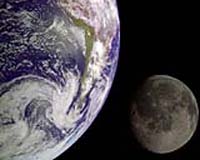 |
Los Alamos NM (SPX) Aug 09, 2010 A team of scientists used an ion beam in a basement room at Los Alamos National Laboratory to simulate solar winds on the surface of the Moon. The table-top simulation helped confirm that the Moon is inherently dry. In research published in Science Express, Zachary Sharp of the University of New Mexico and a team of scientists from California, Texas and New Mexico-including Yongqiang Wang, leader of Los Alamos' Ion Beam Materials Lab-present an analysis of chlorine isotopic ratios in lunar rock samples that seem to indicate that the Moon never had water of its own. Many scientists believe that the Moon formed when a large object collided with Earth early in its formative stages, leaving behind a blob of material that became trapped in orbit around the nascent Earth. Because most of the water on Earth likely came from water liberated from molten basalts as they cooled, researchers have often wondered whether the Moon's geology contains similar concentrations of trapped water. Sharp and his team examined ratios of stable chlorine isotopes-chlorine-35 and chlorine-37-in terrestrial and lunar rock samples. Chlorine readily interacts with hydrogen and is highly volatile. Consequently, the ratio and concentrations of these isotopes can provide a "fingerprint" of water content of volcanic rocks. If the Moon were formed via cataclysmic collision of a foreign body with a fledgling Earth, it's reasonable to assume that lunar basalts would share a similarly soggy history as their earthen brethren. However, an analysis of the chlorine isotopic ratios of rocks from the Earth and Moon provided vastly different fingerprints. Sharp and his team came up with three possible explanations for the differences: 1) the moon-forming collision homogenized molten material from Earth and the colliding body into a material with a unique composition, 2) hydrogen-rich solar winds buffeting the moon preferentially stripped away one isotopic chlorine species from rocks, or 3) lunar basalts were inherently anhydrous. The researchers dismissed the homogenization scenario after comparing observed chlorine isotope concentrations with other volatile elements in the basalts. The other volatile chemicals did not behave consistently with what would have been expected for the homogenization scenario. To assess the effects of solar winds, Los Alamos researcher Wang took a thin film of sodium chloride-the same chemical as ordinary table salt-and bombarded it with a stream of protons (hydrogen ions) at Los Alamos' Ion Beam Materials Lab. If the rocks were to be affected by the solar winds, the lighter chlorine isotope, chlorine-35, would preferentially react with the protons and be carried away as hydrogen chloride (HCl) gas. If this scenario were true, researchers would then find slightly higher ratios of the heavier isotope in the rocks. After subjecting the sample to eons of "solar-wind" exposure, the research team found that the samples were essentially unaffected by the proton onslaught. Furthermore, lunar rocks from the surface showed depleted values of chlorine-37 relative to the lighter chlorine-35 isotope, and subsurface lunar rock samples shielded from solar winds had higher, not lower, concentrations of chlorine-37. These findings helped dismiss the second scenario. The research team found that the third scenario-that the moon was inherently without water-was supported by the lunar rock samples because the residual chlorine isotopes found in the rocks seem to have originated from metal chlorides such as sodium chloride, zinc chloride and iron chloride, which have been seen as surface coatings on lunar volcanic rocks. With regard to scientific findings of water-ice in lunar surface samples, the likely source is from comets, not the Moon itself. Other researchers have published papers contradicting the team's findings. Sharp says the reason behind the discrepancies in his team's research and previous research is not well understood yet, and will require further analysis. Even though his laboratory helped simulate the moon, Los Alamos researcher Wang remains down to Earth. "It was very gratifying to play a role in the research and to be able to exclude one argument more definitively than before," Wang said. The research team included Sharp and Chip Shearer of the University of New Mexico; Kevin McKeegan of the University of California at Los Angeles; Jamie Barnes of the University of Texas; and Wang of Los Alamos National Laboratory.
Share This Article With Planet Earth
Related Links Los Alamos National Laboratory Mars News and Information at MarsDaily.com Lunar Dreams and more
 Russia To Launch Moon Probe In 2012
Russia To Launch Moon Probe In 2012Razvilka, Russia (RIA Novosti) Aug 05, 2010 Russia's Federal Space Agency Roscosmos will launch a probe bearing a neutron generator to study the moon's surface in 2012, a leading space researcher said on Tuesday. "Roscosmos plans to send to the moon a spacecraft bearing a neutron generator developed by our institute to study lunar surface," said Yevgeny Bogolyubov, deputy chief designer of the Automation Engineering Scientific Resea ... read more |
|
| The content herein, unless otherwise known to be public domain, are Copyright 1995-2010 - SpaceDaily. AFP and UPI Wire Stories are copyright Agence France-Presse and United Press International. ESA Portal Reports are copyright European Space Agency. All NASA sourced material is public domain. Additional copyrights may apply in whole or part to other bona fide parties. Advertising does not imply endorsement,agreement or approval of any opinions, statements or information provided by SpaceDaily on any Web page published or hosted by SpaceDaily. Privacy Statement |